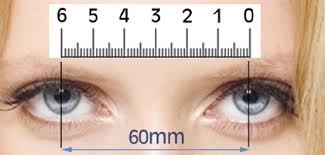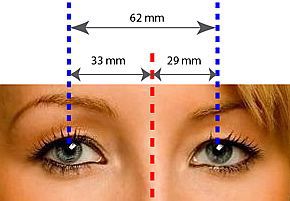Pupillary distance is the horizontal distance between centers of your eye pupils. Pupillary distance is measured in millimeters and is at times referred to as PD. PD is an important measurement as it is used in determining the proper alignment for your spectacles. If an inaccurate pupillary distance measurement is used, correcting one’s vision might be a difficult task. For proper clarity, your lenses should be aligned over the centers of your pupils. Read on to find out how to measure pupillary distance.
How to Measure Pupillary Distance by Yourself


Adults normally have a pupillary distance between 54 and 72 mm and children 41 to 55mm. There are 2 ways of measuring pupillary distance. The first is known as binocular. This involves measuring from pupil to pupil and it gives a range of 41 to 80 mm. The second is monocular where by the distance measured is from the pupil to the middle of your face and both sides should be measured. This normally gives a result of 20 to 40mm. For people with faces that are asymmetrical, that is, one eye is closer to the middle of the face than the other is. This method is the best.
Here is how you can measure pupillary distance using a millimeter ruler:
- You will need a mirror and a ruler
- Stand 8 inches away from the mirror
- Looking at the mirror with your head straight and place the ruler on your brow
- Ensure that the zero mark is aligned to the center of your left pupil while your right eye is shut
- Close the left eye and open the right eye
- The mm mark that is right above the center of your right pupil is your pupillary distance
- Take several measurements to get a consistent reading.
Tips: measure more than twice so that you get a consistent and accurate result.
Here’s a video showing step-by-step instruction for measuring pupillary distance:
How to Have a Friend to Measure Pupillary Distance
This is how to measure pupillary distance with your friend, which is quite easy to do:
- While your friend is standing opposite you at the same height, ask her to place a ruler on your brow with the mm marks pointing the eyes
- Tell her to close her right eye and then you look straight into her left eye. Let her slide the ruler such that the zero reading is right above the center of your right eye
- Then tell her to shut her left eye and you look straight into her right eye. The reading that is above the center of your left pupil id your pupillary distance.
Video that shows in detail how to measure pupillary distance with the help of your friend:
Pupillary Distance Measurement on Prescription
Where is my pupillary distance on my prescription?Your PD measurement is normally written at the bottom of the prescription.
There are different ways in which your pupillary distance can appear on your prescription. Below is an illustration of how PD is often written.

In case your PD isn’t on your prescription, you can always ask your eyecare provider to do it for you. They might charge an extra fee, but some will include it in your eye exam. If this is not possible, you can measure the PD yourself as detailed above.
